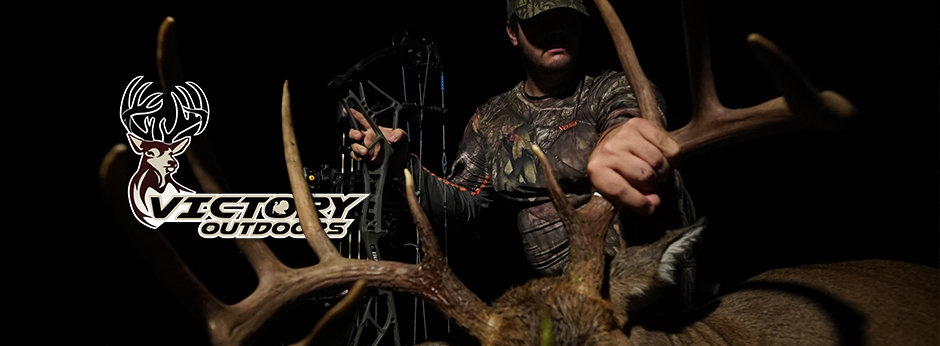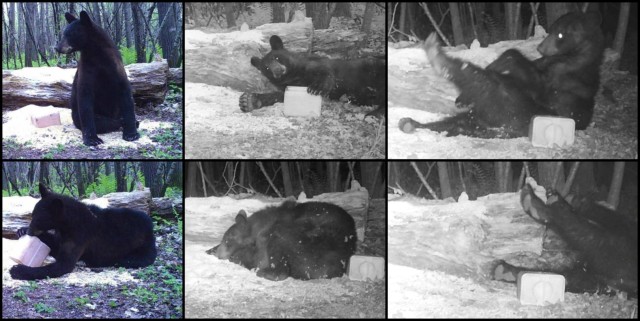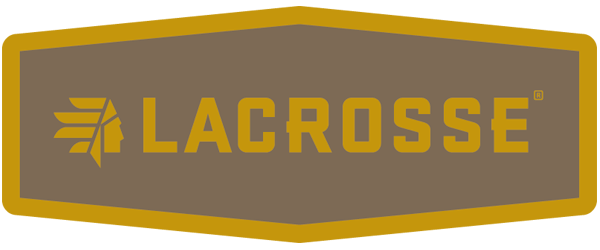By Skye Goode
As most know, I run my trail cameras year round because I love to get pictures of any critter that walks the woods. This time of year, year after year, my cameras are run down with pictures of hungry black bears that have emerged from a long hibernation and are in search of two things: food, and a mate. Black bear mating season occurs mid-June and can last until early August. During this time, bears are in search of a breeding partner, but also trying to fill themselves back out after losing large amounts of fats over the winter. Boars will breed with several different sows through the summer, except those that already have this year’s cubs with her. Bear sightings during the day are more common, as their judgment is clouded, much like strutting toms or rutting bucks, and the fear of people is somewhat forgotten as they try to breed. A few summers ago, I was walking my beagle at high noon and encountered a male chasing a female through an open hay field. 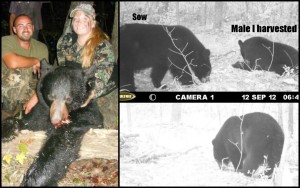 The female crossed the county road, but as several cars stopped to check him out, the male was caught on the other side of the road. He pawed at the ground, growled, huffed and puffed, upset that the cars were deterring him from crossing the road to pursue his female.
The female crossed the county road, but as several cars stopped to check him out, the male was caught on the other side of the road. He pawed at the ground, growled, huffed and puffed, upset that the cars were deterring him from crossing the road to pursue his female.
I’ve already had several different bears of various sizes and ages this spring on my cameras that span a three county area. Unfortunately, it takes years to draw a kill tag in my area, and after filling my 2012 archery bear tag, I find myself waiting until 2016 for my next chance to hunt. The night I harvested my male, he came in with a smaller sow pictured below. I’m glad that I was able to see the difference and harvested a mature male versus a sow that will potentially produce offspring for future hunting generations.
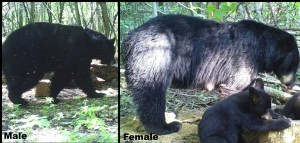 Regardless, I love seeing the different bears that walk through, and it’s great to practice aging and sizing black bears, which can be difficult with the long, heavy fur and lack of a “monster rack” to judge. Bears are categorized as trophies by the size of their skull; something difficult to gauge as you stand shaking in a treestand. Neck size and ear length are the two things I look at when aging a bear. Flipping through trail camera pictures, I can see that I have several yearling cubs coming in, evident by their huge ears and lanky legs. It is also good practice to learn the difference between males and females, as taking a sow with cubs is considered unlawful. Often times, especially in the later part of fall, cubs won’t be right at the heels of the sow, so you could potentially put your tag on a mother bear when the cubs were a ways behind. Much like a dairy cow, boars will have broad shoulders and thick neck, and a straight back with a hump around the shoulder area, whereas sows will typically have a swayback, a large hindquarter area, and a smaller face/head with a flatter forehead.
Regardless, I love seeing the different bears that walk through, and it’s great to practice aging and sizing black bears, which can be difficult with the long, heavy fur and lack of a “monster rack” to judge. Bears are categorized as trophies by the size of their skull; something difficult to gauge as you stand shaking in a treestand. Neck size and ear length are the two things I look at when aging a bear. Flipping through trail camera pictures, I can see that I have several yearling cubs coming in, evident by their huge ears and lanky legs. It is also good practice to learn the difference between males and females, as taking a sow with cubs is considered unlawful. Often times, especially in the later part of fall, cubs won’t be right at the heels of the sow, so you could potentially put your tag on a mother bear when the cubs were a ways behind. Much like a dairy cow, boars will have broad shoulders and thick neck, and a straight back with a hump around the shoulder area, whereas sows will typically have a swayback, a large hindquarter area, and a smaller face/head with a flatter forehead.
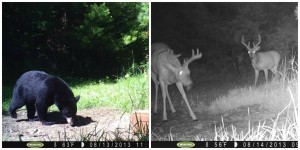 It’s a common misconception that having a large amount of bear in your hunting woods will deter bucks from staying in your area. It is true that if given the opportunity, bears will pray on young fawns. If a hunter is targeting bears specifically by keeping an active bait site in the area, then yes, the deer population will tend to avoid said feeding ground. I keep mineral sites in my woods that are not targeting any one species. I have an equal amount of furbearers, black bear, small game and deer, including some decent bucks that frequent the area throughout the rut, even though, like clockwork, bears are passing through to check out the mineral site.
It’s a common misconception that having a large amount of bear in your hunting woods will deter bucks from staying in your area. It is true that if given the opportunity, bears will pray on young fawns. If a hunter is targeting bears specifically by keeping an active bait site in the area, then yes, the deer population will tend to avoid said feeding ground. I keep mineral sites in my woods that are not targeting any one species. I have an equal amount of furbearers, black bear, small game and deer, including some decent bucks that frequent the area throughout the rut, even though, like clockwork, bears are passing through to check out the mineral site.
Cubs are often the worst offenders and will hang around mineral sites, I think, because they are bored and lonely. This young cub, for instance, stayed at this site for 4+ hours one night. Judging by his age, I think he was recently kicked off from his sow as she was ready to breed, so he appears to be bored and in search of a playmate.
